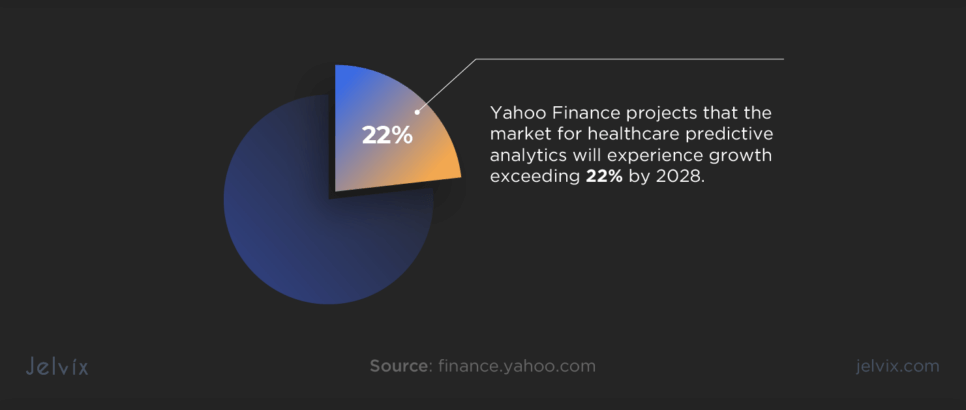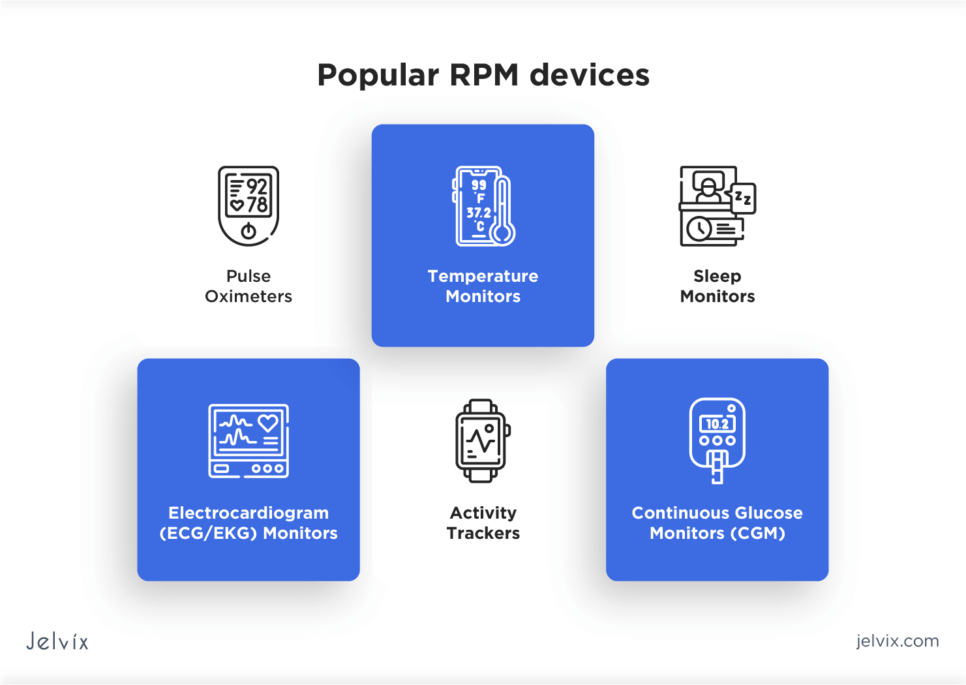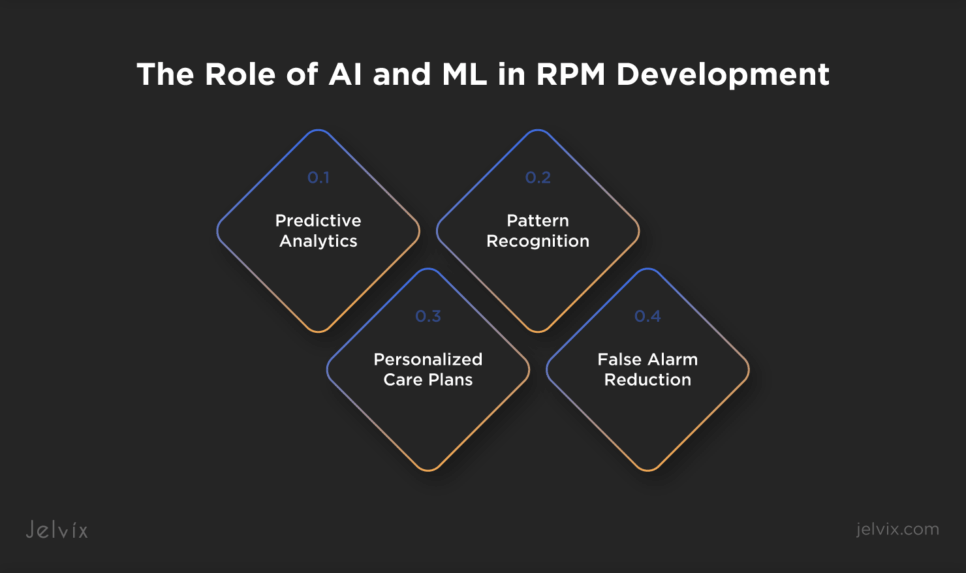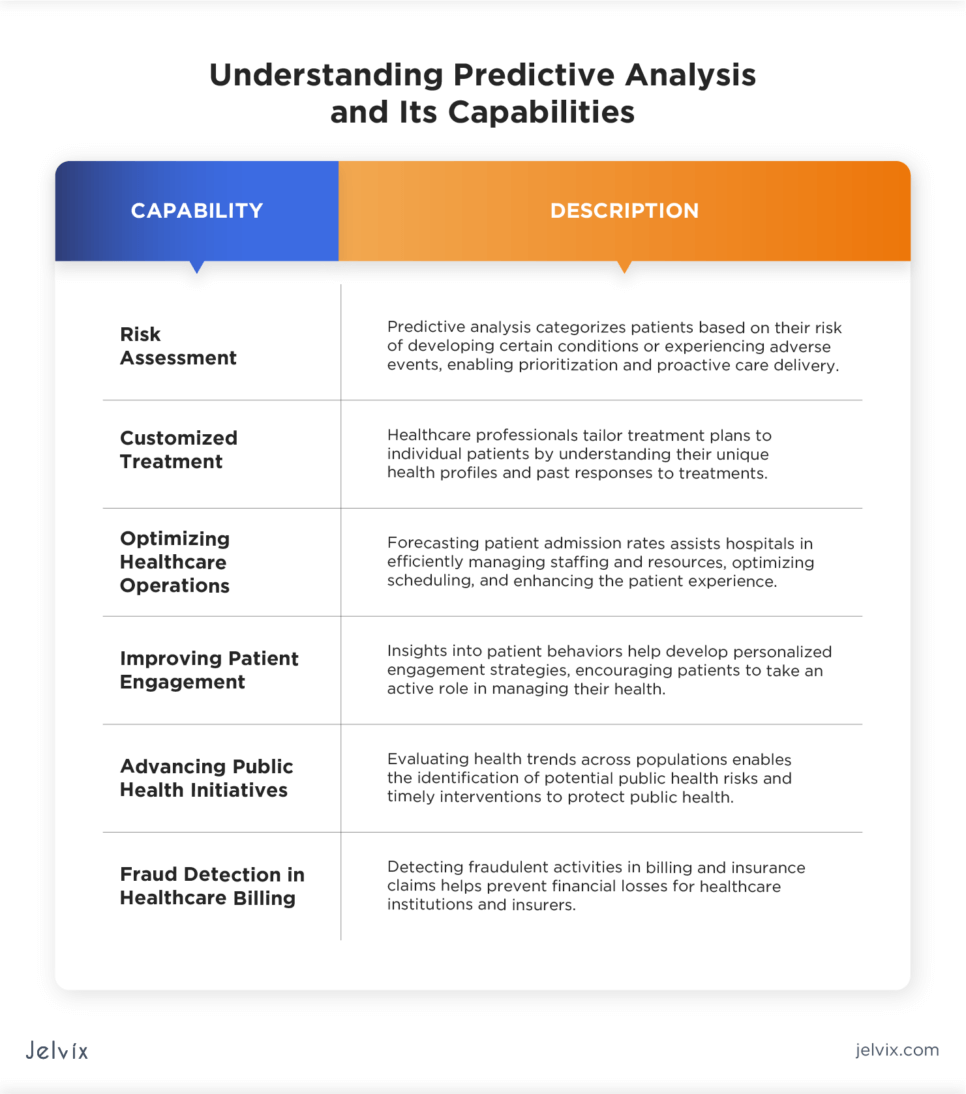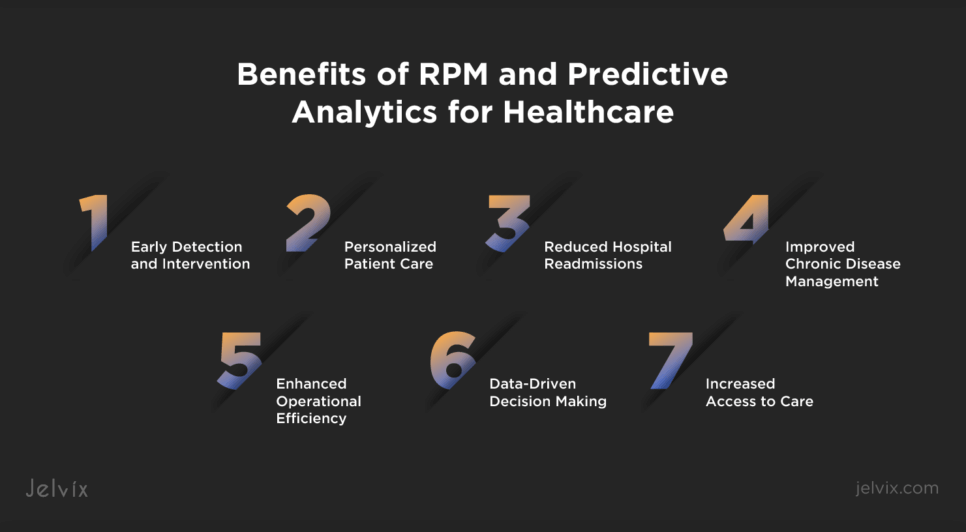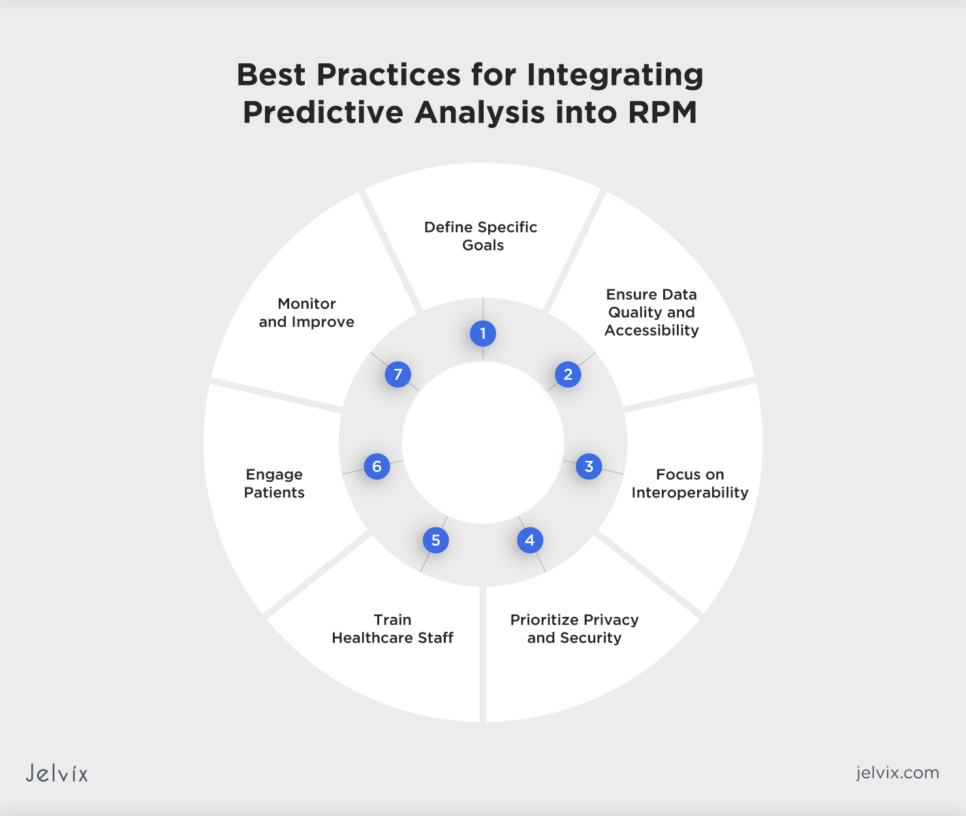Remote patient monitoring has proven invaluable during the pandemic. It enabled hospitals to observe and treat patients remotely, minimizing the risk of spreading the virus. The wealth of real-time data provided by RPM devices became a source of health info for predictive analytics contributing to personalized treatments.
Yahoo Finance projects that the market for healthcare predictive analytics will experience growth exceeding 22% by 2028. This highlights that healthcare organizations are keen to adopt RPM for predictive analysis. However, integrating this tech involves challenges of ensuring data quality, adhering to industry regulations, and tackling technical barriers.
If you’re looking to leverage RPM technologies to improve healthcare delivery and patient outcomes, keep reading. You’ll discover the benefits of predictive RPM, its implementation obstacles, and best practices for smooth integration.
The Foundation of RPM
The concept of remote patient monitoring is not entirely new. It developed over the years thanks to advancements in technology and changing healthcare industry demands. Initially, RPM was limited to simple remote monitoring tools, like call-in systems for patients to report their health status. However, the development of digital technology transformed remote monitoring, expanding its capabilities to capture vital patient signs in real time and transfer the data to physicians.
The Current State of RPM in Healthcare
In recent years, RPM has received wide adoption among doctors and patients. About 23 million patients used technologies fаor remote monitoring in 2020. What’s more, 96% of patients who participated in the COVID-19 Home Monitoring program in 2020-2021 successfully recovered.
Today, RPM is widely adopted across various healthcare settings, from chronic disease management to post-operative care, thanks to its proven benefits in improving patient outcomes and reducing healthcare costs.
In addition, regulatory frameworks and reimbursement policies supported the use of RPM in clinical practice. For instance, in the U.S., Medicare and other insurers have expanded coverage for RPM services, recognizing their value in patient care.
Technological Innovations Fueling Predictive Monitoring
RPM has quickly developed thanks to major tech improvements. These new developments have made RPM a key part of today’s healthcare. Artificial intelligence (AI), machine learning (ML), and big data analytics pushed RMP solutions forward, making healthcare more tailored and proactive.
The Role of AI and Machine Learning in RPM Development
AI and ML enhanced RPM by providing the immediate analysis and interpretation of patient data. These technologies allowed for the automation of complex processes, improving the accuracy and efficiency of patient monitoring:
- Predictive analytics: AI and ML algorithms can analyze historical health data to predict future health events, enabling early intervention for conditions that can escalate;
- Pattern recognition: these technologies together with ML can identify patterns and anomalies in vast datasets, such as detecting changes in a patient’s vital signs that may indicate emerging health issues;
- Personalized care plans: AI-driven RPM systems can help physicians tailor care plans to the individual needs of patients by analyzing their specific health data and learning from ongoing treatment outcomes;
- Reducing false alarms: with AI and ML, RPM systems can better differentiate between normal and concerning health data. This reduces unnecessary alarms, helping doctors focus on real health issues.
The integration of AI and ML into RPM systems not only enhanced the capability to monitor patients more effectively but also improved the decision-making process in patient care.
Big Data Analytics and Its Impact on RPM
Big data analytics enables RPM to analyze large volumes of health data and uncover previously inaccessible insights. Big data analytics complements the capabilities of AI and ML, offering deep insights into patient health and enhancing the overall quality of care:
- Comprehensive health insights: processing vast amounts of data from RPM devices, big data analytics offers a complete picture of a patient’s health. This means doctors can make better-informed decisions, leading to improved patient care;
- Spotting trends and patterns: by analyzing vast datasets, physicians can identify trends and patterns in patient health. This can lead to earlier interventions for diseases and more effective management of chronic conditions;
- Efficient care: analyzing RPM data helps find ways to make healthcare delivery more efficient. It can show where resources are needed most, saving time and reducing costs;
- Engaged patients: insights from big data analytics can be used to give patients personalized feedback and recommendations and encourage them to take an active role in managing their health.
Predictive Health Analytics in RPM
Predictive analysis operates on the principle that historical data contains valuable patterns that, if correctly identified and interpreted, can provide insights into future outcomes. The accuracy of these predictions depends on the quality of the data, the sophistication of the analysis methods, and the expertise of the analysts.
Understanding Predictive Analysis and Its Capabilities
Predictive analysis transforms reactive healthcare systems into proactive ones, where prevention and early intervention lead the way. By analyzing data from electronic health records and wearable devices, predictive analysis offers a range of capabilities that can lead to informed decision-making and proactive healthcare strategies.
Risk Assessment
The predictive analysis enables healthcare pros to categorize patients based on their risk of developing certain conditions or experiencing adverse events. This risk evaluation can help doctors prioritize patients who need more intensive monitoring or intervention, improving care delivery and preventing hospital readmissions.
Customized Treatment
One of the most significant capabilities of predictive analysis is its ability to assist physicians in tailoring treatment plans to individual patients. By understanding a patient’s unique health profile and how similar profiles responded to various treatments in the past, healthcare pros can customize treatment strategies that are more likely to be effective for the individual.
Optimizing Healthcare Operations
Predictive analysis can forecast patient admission rates, helping hospitals manage staffing and resources efficiently. Predictive models can identify potential bottlenecks in patient flow, enabling healthcare facilities to optimize scheduling, reduce wait times, and enhance the overall patient experience.
Improving Patient Engagement
Through predictive analysis, physicians can gain insights into patient behaviors that may impact their health, such as medication adherence or lifestyle choices. This information can be used to develop personalized engagement strategies that encourage patients to take an active role in managing their health.
Advancing Public Health Initiatives
On a broader scale, predictive analysis can evaluate health trends across populations, identifying potential public health risks, such as outbreaks of infectious diseases. This capability enables public health officials to implement timely interventions and protect the health of the public.
Fraud Detection in Healthcare Billing
In the financial aspect of healthcare, predictive analysis can detect patterns indicative of fraudulent activities in billing and insurance claims. This capability helps healthcare institutions and insurers save significant amounts of money and resources by preventing fraud.
Successful Implementation of RPM and Predictive Analysis in Healthcare
Case studies provide real-world evidence of how RMP and predictive analysis can positively affect healthcare outcomes. These success stories highlight common obstacles in deploying new medical solutions, informing others about potential challenges and ways to overcome them.
Supporting Patients with Cardiac Conditions
Baptist Health South Florida teamed up with Raziel Health to enhance its cardiac care services. Implementing RPM resulted in significant improvements in cardiac patient care. The real-time and predictive capabilities of the system allowed healthcare providers to proactively manage patients’ conditions, reducing the risk of emergency hospitalizations and improving overall health outcomes.
Improving Hypertension Care
FQHC partnered with Robeson Health Care Corporation to enhance hypertension care management. By using advanced RPM technology, over 2,500 patients were able to monitor their hypertension from home using pre-configured blood pressure monitors and AI-enabled care coordination tools. This approach helped enhance patient access, satisfaction, and outcomes while reducing healthcare costs.
Reducing Readmission Rates
The Mount Sinai Health System in New York implemented an RPM program for patients with Chronic Obstructive Pulmonary Disease (COPD) using predictive analytics. The program significantly reduced COPD-related readmission rates by identifying at-risk patients before their conditions worsened. As a result, physicians were able to intervene earlier with adjustments to treatment or in-home care visits.
Benefits of RPM and Predictive Analytics for Healthcare
Predictive RPM represents a significant move forward in healthcare, combining the advantages of traditional RPM with the foresight offered by predictive analytics. This innovative approach enhances patient care, operational efficiencies, and overall health outcomes, offering numerous benefits to patients and physicians.
Early Detection and Intervention
As noted earlier, predictive RPM allows for the detection of potential health issues before they escalate into more serious conditions. For example, it can predict the onset of chronic diseases like diabetes or heart disease, enabling early intervention strategies that can mitigate the impact of the illness.
Personalized Patient Care
With the insights gained from predictive RPM, physicians can tailor care plans to the individual needs of each patient. This personalized approach not only enhances the effectiveness of treatment plans but also increases patient engagement and satisfaction. Patients are more likely to adhere to a care plan that is specifically designed for them rather than following common treatment instructions.
Reduced Hospital Readmissions
By keeping a close eye on patients’ health status and predicting potential adverse events, predictive RPM can significantly reduce the need for hospital readmissions. This not only has a positive impact on patient outcomes but also helps to alleviate the financial burden on healthcare systems. Reduced readmissions lead to lower healthcare costs and more efficient use of resources.
Improved Chronic Disease Management
Predictive RPM is effective in managing chronic diseases such as diabetes and heart disease. It enables continuous monitoring of a patient’s health indicators, allowing for adjustments in treatment plans as needed. Predictive analytics can forecast disease outbursts, enabling preventative measures to be taken in advance.
Enhanced Operational Efficiency
Healthcare providers can use the insights from predictive RPM to optimize their operations, including staffing levels, resource allocation, and patient scheduling. By predicting periods of high demand or identifying which patients require more intensive monitoring, healthcare facilities can ensure that their resources are used efficiently.
Data-Driven Decision Making
Predictive RPM provides physicians with a wealth of data that can inform clinical decision-making. This data-driven approach ensures that decisions are based on specific information. Furthermore, the aggregated data can be used for broader patient analytics, contributing to research and the development of new treatment protocols.
Increased Access to Care
Predictive RPM enables the delivery of high-quality care to patients regardless of their location. This is especially beneficial for patients in remote or underserved areas, who can receive the same level of monitoring and care as those in more accessible locations. Increased access to care helps to reduce health disparities and ensures that all patients can benefit from advanced healthcare technologies.
Explore the ins and outs of building a Remote Patient Monitoring App and learn about the essential features, development process, and benefits of remote healthcare technology.
Key Challenges of Implementing Predictive RPM
Although remote patient monitoring benefits are truly impressive, the implementation process comes with its share of challenges that healthcare entities should take into account.
Technological and Infrastructure Barriers
The foundation of predictive health diagnostics in RPM is built on advanced technologies, including big data and artificial intelligence. Ensuring these technologies work seamlessly together, and integrating them with existing healthcare systems pose significant challenges. The need for a robust infrastructure to support the data volume and analytics processes can complicate implementation.
The Jelvix team recommends that you invest in scalable IT infrastructure that can grow with your program. Choose interoperable solutions that can easily integrate with existing systems and prioritize flexible technologies that allow for phased implementation and testing. Also, partner with providers offering comprehensive support and customizable solutions to let you stay updated and competitive.
Regulatory and Privacy Considerations
Protecting patient data and ensuring compliance with healthcare regulations, such as HIPAA in the U.S. and GDPR in the EU is critical. The dynamic nature of healthcare regulations, coupled with varying international privacy standards, can complicate your compliance efforts.
Make sure to establish a robust data governance framework that prioritizes patient privacy and data security. Consider implementing security measures, such as AES and RSA encryption algorithms, role-based access controls, and multifactor authentication, to protect patient data against breaches and unauthorized access.
Digital Divide and Patient Access
The effectiveness of predictive RPM depends on patients’ ability to use RPM devices and engage with digital health platforms. Technological literacy varies widely among populations, potentially limiting the accessibility for some patients. This divide can limit the effectiveness of predictive RPM programs, as users without access to necessary technology or the Internet may be unable to participate.
Consider developing mobile health solutions that are compatible with a wide range of devices, including basic smartphones, to broaden access to care. Offer RPM devices to patients as part of the program to ensure they have all the necessary tools. Implement training programs to help patients understand how to use RPM devices and interpret the data from them. Also, work with community organizations or local governments to improve technology access in underserved areas.
Best Practices for Integrating Predictive Analysis into RPM
Integrating predictive analysis into RPM requires careful planning, execution, and continuous improvement to maximize patient outcomes. The following best practices will help healthcare organizations conduct the integration successfully, minimizing workflow disruptions.
1. Define Specific Goals
Clearly define what you aim to achieve with predictive analysis in your RPM program, whether it’s reducing hospital readmissions, managing chronic diseases, or improving patient outcomes. Establish measurable indicators to track the success of your predictive analysis integration, allowing for efficiency assessment.
2. Ensure Data Quality and Accessibility
Ensure the RPM system collects a wide range of data types, including physiological data, patient-reported outcomes, and environmental factors, to include in predictive models. Regularly clean and standardize data to ensure high-quality care and consistency for accurate predictive analysis.
3. Focus on Interoperability
Prioritize interoperability and its data standards, such as HL7 and FHIR, within your RPM and other healthcare systems to facilitate data sharing and analysis. Select predictive analytics tools and software that are compatible with your existing RPM technologies to streamline integration and implementation.
4. Prioritize Privacy and Security
As noted earlier in this article, ensure compliance with all relevant privacy and security regulations to protect patient data. If you plan to integrate AI capabilities, consider adhering to the EU AI Act that regulates the safe use of artificial intelligence. Use data encryption, access controls, and cloud data storage to safeguard patient information at every stage of the RPM process.
5. Training Healthcare Staff
Educate healthcare pros on how to interpret and act on insights generated by predictive analysis, so that they can effectively integrate this information into patient care. Establish channels for physicians to give feedback on the predictive analysis tools and insights to facilitate improvement and alignment with clinical needs.
6. Engaging Patients
Educate patients on the benefits and operation of the RPM system, including how predictive analysis will be used to enhance their care. Obtain informed consent from patients and be transparent about how their data will be used for predictive analysis.
7. Monitor and Improve
Continuously monitor the performance of predictive analysis within the RPM system against established KPIs to identify areas for improvement. Use feedback from doctors and patients, along with performance data, to make iterative improvements to the predictive analysis integration, optimizing its effectiveness over time.
By following these best practices, healthcare organizations can successfully integrate predictive analysis into RPM systems, unlocking the potential to enhance patient care, improve health outcomes, and optimize operational efficiencies.
The Future of RPM and Predictive Healthcare
The future of RPM and predictive healthcare will be generally formed by collaboration between technologists, healthcare professionals, researchers, and policymakers. By following Medicare’s example, insurance companies will encourage more patients to participate in remote monitoring programs.
ReportLinker forecasts that the global market for RPM will expand to $175.2 billion by 2027. This growth is largely attributed to the increasing adoption of wearable technology. What’s more, RPM has the potential to reduce hospitalizations by up to 87% and deaths by about 77% due to comprehensive at-home monitoring and analytics.
Advancing RPM in Healthcare with Custom Solutions
Custom RPM solutions powered with predictive analysis offer the flexibility to address the unique challenges and requirements of different healthcare scenarios. At Jelvix, we strive to design healthcare tech that meets the specific needs of healthcare organizations and their patients.
We developed a telehealth solution with an RPM module to track patients’ vital signs and immediately send them to doctors. As a result, we helped the clinic to cut the administrative burden by 25% and reduce unnecessary hospital visits by 30%.
If you want to learn more about this solution’s impact on healthcare delivery or seek guidance on developing your own RPM application, please contact us. Our experts are available to provide insights and answers to any inquiries.
Looking for an innovative tech partner?
Expand your development capabilities with our skilled and dedicated team.


